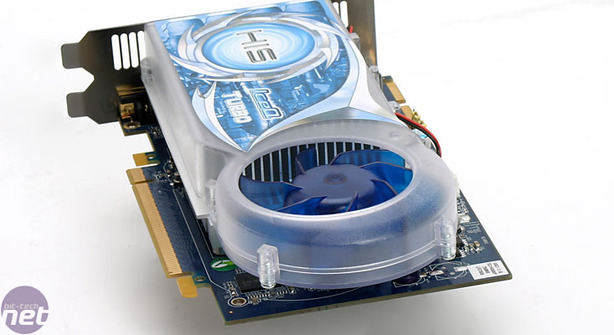Overclocking:
We set about overclocking HIS’s Radeon HD 2600 XT IceQ Turbo GDDR3 graphics card using AMD’s the overclocking tool that’s built into ATI Catalyst Control Center. After a couple of hours of tweaking and gameplay, we managed to get the card running without stability or image quality issues at 860MHz core and 2120MHz memory.Over the factory set clock speeds, the results aren’t that great when it comes to the core clock increase, but the memory clock is reasonably impressive. If you take the core increase over AMD’s reference clock of 800MHz, the results are a little more impressive though.
In terms of the memory overclock, we managed to get the chips to run stable at 120MHz over their rated speed. Being Samsung BJ1A DRAMs, they’re rated to 1.0ns or 1000MHz (2000MHz effective), so 2160MHz is quite a good result. On the performance front, this gave us an extra couple of frames per second in Company of Heroes at 1280x1024 using the DirectX 10 renderpath.

Final Thoughts...
HIS’s Radeon HD 2600 XT IceQ Turbo GDDR3 graphics card showed a lot more promise than the GDDR4-based Sapphire HD 2600 XT we looked at last week, but we still don’t think it’s quite enough to really make a consistent challenge against its competitors. Both the GeForce 8600 GT and the previous generation of mid-range hardware performs better on average when anti-aliasing is enabled. In many of these cases with AA enabled, the frame rate delivered by these cards is a playable one – the same cannot be said for the Radeon HD 2600 XT unfortunately.With that said though, the card is a good performer when anti-aliasing is disabled and thus it depends whether anti-aliasing is important to you or not. If you’re the latter, HIS’s Radeon HD 2600 XT IceQ Turbo GDDR3 delivers a reasonable gameplay experience and comes with DirectX 10 support to boot. Therefore, the decision comes down to whether DirectX 10 support is important to you at this time.
By and large, the current DirectX 10 games don’t show any compelling reason to upgrade to DX10 hardware, but that may change later this week with BioShock hitting the shelves. Of course, there are many other potential triple-A titles coming later this year too and, we’ll be looking at the performance of each game as and when it comes out.
At around £75 (inc. VAT), the card is around £10 cheaper than Sapphire’s GDDR4-based 2600 XT. Based on the differences in performance and price, the HIS 2600 XT IceQ Turbo GDDR3 looks like a bargain compared in isolation to the Sapphire HD 2600 XT GDDR4. However, when you throw the 8600 GT into the mix, for which a standard clocked card can be purchased for around £5 less than HIS’s card, and the decision becomes a little trickier.
The Radeon X1950 Pro is a better buy right now because of the lack of compelling DX10 content available at the moment. However, that could change as soon as the end of the week, when potentially the biggest game of the year (which comes complete with DX10 support) is released. Waiting until then would be advisable in our opinion, but if you’re dead set on buying a DirectX 10 card today, both the GeForce 8600 GT and Radeon HD 2600 XT should deliver respectable performance in upcoming DX10 titles. The question is though, whether that DX10 gaming experience will be better than the DX9 experience achievable on a Radeon X1950 Pro – that is something we hope will become clearer over the next couple of weeks.
- Features
- x
- x
- x
- x
- x
- x
- x
- x
- x
- -
- 9/10
- Performance
- x
- x
- x
- x
- x
- x
- -
- -
- -
- -
- 6/10
- Value
- x
- x
- x
- x
- x
- x
- -
- -
- -
- -
- 6/10
- Overall
- x
- x
- x
- x
- x
- x
- x
- -
- -
- -
- 7/10

MSI MPG Velox 100R Chassis Review
October 14 2021 | 15:04









Want to comment? Please log in.